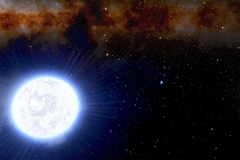Astronomers in the US and Canada have discovered a star-eating pulsar 2674 light-years from Earth

Image: NOIRLab / NSF / AURA / J. da Silva
Astronomers in the United States and Canada have discovered for the first time a system of two stars, one of which is a newly formed pulsar 2,674 light-years from Earth. A neutron star is pulling matter from a neighboring star, which is doomed to turn into a white dwarf. Preliminary results are published in the preprint of the article, available on the arXiv website.
The unusual gamma-ray source 4FGL J1120.0-2204 was originally spotted by the Fermi space telescope. The researchers speculated that it could be a millisecond pulsar (MSP), a neutron star that rotates very quickly due to accretion of matter from a neighboring star. Most of the known SMEs in the Milky Way galaxy have passed the acceleration stage and are gradually decelerating their rotation, and their companions are helium white dwarfs, which can no longer transfer their matter to a neutron star.
The Fermi Space Telescope has detected many new bright sources of gamma rays in the Milky Way. Multiwavelength observations have identified them as millisecond pulsars whose companions are hydrogen-rich main-sequence stars. Such objects are called “spider” pulsars because they devour the matter of neighboring stars. They are further subdivided into two subclasses: “black widows” (the mass of the companion is less than 0.05 solar masses) and “red backs” if the companion star retains more mass.
4FGL J1120.0-2204 was the second brightest unidentified gamma ray source. Astronomers analyzed the source's spectrum using the SOAR (The Southern Astrophysical Research) telescope and found that the object is a binary system with a rather hot companion, whose orbital period is 15 hours. The gamma source is most likely a millisecond pulsar that is 820 parsecs (2674 light years) away. The companion star has a mass of 0.17 times the mass of the Sun, meaning it is in an intermediate stage of transformation into a helium white dwarf.
According to models, in two billion years the properties of this unusual system will match those of a typical short-period white dwarf pulsar system. Thus, 4FGL J1120.0-2204 is most likely the “missing link” in the evolution of such binary systems.

